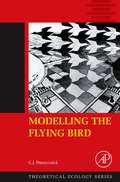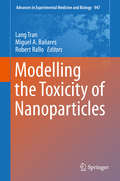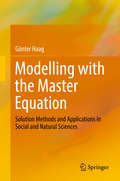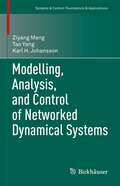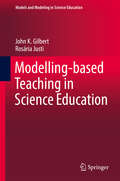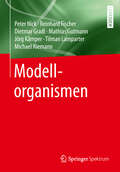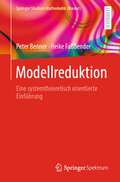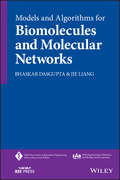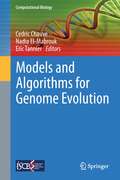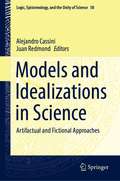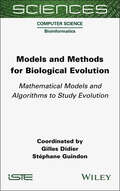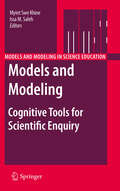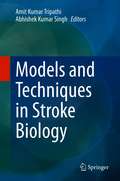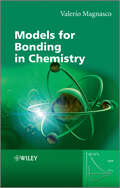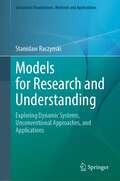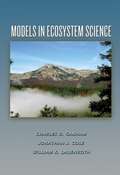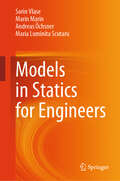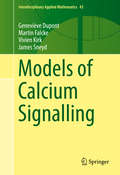- Table View
- List View
Modelling the Fate of Chemicals in the Environment and the Human Body
by Philippe Ciffroy Alice Tediosi Ettore CapriThis volume focuses on modelling the fate of chemicals in the environment and the human body to arrive at an integrated exposure assessment. It covers five broad topics, namely: future challenges in exposure assessment; the evolution of human health and environmental risk assessment; standard documentation for exposure models; modelling different environmental components (i. e. surface waters, atmosphere, soil, groundwater, plants, aquatic organisms and mammals); and the fate of contaminants in humans. This work draws on the authors' and editors' extensive experience and a range of different research activities, including case studies, that have led to the development of MERLIN-Expo, a standardised software package for simulating the fate of chemicals in the main environmental systems and in the human body in an integrated manner. It will be of considerable interest to researchers and students, risk managers, and policy- and decision-makers whose work involves environmental protection and human health.
Modelling the Flying Bird
by C. J. PennycuickThis book outlines the principles of flight, of birds in particular. It describes a way of simplifying the mechanics of flight into a practical computer program, which will predict in some detail what any bird, real or hypothetical, can and cannot do. The book and the program are based on adapting the conventional (and well-tested) thinking of aeronautical engineers to the biological problems of bird flight. Their primary aim is to convince biologists that this is the appropriate way to handle problems that involve flight, to make the engineering background accessible to biologists, and to provide a tool kit in the shape of the Flight program, which they can use to solve practical problems involving bird flight and migration. In addition, the book will be readily accessible to engineers who want to know how birds work, and should be of interest to the ever-growing community working on flapping "micro air vehicles" (MAVs). The program can be used to predict the flight performance and capabilities of reconstructed fossil birds and pterosaurs, flying in ancient atmospheres that differ from present conditions, and also, of course, to predict and account for the results of experiments and observations on living birds and bats. * An up to date work by the world's leading expert on bird flight * Examines the biology and biomechanics of bird flight with added reference to the flight of bats and pterosaurs. * Uses proven aeronautical principles to help solve biological issues in understanding and predicting the flight capabilities of birds and other vertebrates. * Provides insights into the evolution of flight and the likely capabilities of extinct birds and reptiles. * Gives a detailed explanation of the science behind, and use of, the author's predictive bird flight simulation program - Flight - which is available on a companion website. * Presents often difficult concepts in easily understood language.
Modelling the Toxicity of Nanoparticles (Advances in Experimental Medicine and Biology #947)
by Lang Tran, Miguel A. Bañares and Robert RalloIn today’s nanotechnology and pharmaceutical research, alternative toxicology testing methods are crucial for ethically and commercially sound practice. This book provides practical guidelines on how to develop and validate quantitative nanostructure-toxicity relationship (QNTR) models, which are ideal for rapidly exploring the effects of a large number of variables in complex scenarios. Through contributions by academic, industrial, and governmental experts, Modelling the Toxicity of Nanoparticles delivers clear instruction on these methods and their integration and use in risk assessment. Specific topics include the physico-chemical characteristics of engineered nanoparticles, nanoparticle interactions, in vivo nanoparticle processing, and more. A much-needed practical guide, Modelling the Toxicity of Nanoparticles is a key text for researchers as well as government and industry regulators.
Modelling with the Master Equation: Solution Methods and Applications in Social and Natural Sciences
by Günter HaagThis book presents the theory and practical applications of the Master equation approach, which provides a powerful general framework for model building in a variety of disciplines. The aim of the book is to not only highlight different mathematical solution methods, but also reveal their potential by means of practical examples.Part I of the book, which can be used as a toolbox, introduces selected statistical fundamentals and solution methods for the Master equation. In Part II and Part III, the Master equation approach is applied to important applications in the natural and social sciences.The case studies presented mainly hail from the social sciences, including urban and regional dynamics, population dynamics, dynamic decision theory, opinion formation and traffic dynamics; however, some applications from physics and chemistry are treated as well, underlining the interdisciplinary modelling potential of the Master equation approach. Drawing upon the author’s extensive teaching and research experience and consulting work, the book offers a valuable guide for researchers, graduate students and professionals alike.
Modelling, Analysis, and Control of Networked Dynamical Systems (Systems & Control: Foundations & Applications)
by Karl H. Johansson Ziyang Meng Tao YangThis monograph provides a comprehensive exploration of new tools for modelling, analysis, and control of networked dynamical systems. Expanding on the authors’ previous work, this volume highlights how local exchange of information and cooperation among neighboring agents can lead to emergent global behaviors in a given networked dynamical system.Divided into four sections, the first part of the book begins with some preliminaries and the general networked dynamical model that is used throughout the rest of the book. The second part focuses on synchronization of networked dynamical systems, synchronization with non-expansive dynamics, periodic solutions of networked dynamical systems, and modulus consensus of cooperative-antagonistic networks. In the third section, the authors solve control problems with input constraint, large delays, and heterogeneous dynamics. The final section of the book is devoted to applications, studying control problems of spacecraft formation flying, multi-robot rendezvous, and energy resource coordination of power networks.Modelling, Analysis, and Control of Networked Dynamical Systems will appeal to researchers and graduate students interested in control theory and its applications, particularly those working in networked control systems, multi-agent systems, and cyber-physical systems. This volume can also be used in advanced undergraduate and graduate courses on networked control systems and multi-agent systems.
Modelling-based Teaching in Science Education
by John K. Gilbert Rosária JustiThisbook argues that modelling should be a component of all school curricula thataspire to provide 'authentic science education for all'. The literature onmodelling is reviewed and a 'model of modelling' is proposed. The conditionsfor the successful implementation of the 'model of modelling' in classrooms areexplored and illustrated from practical experience. The roles of argumentation,visualisation, and analogical reasoning, in successful modelling-based teachingare reviewed. The contribution of such teaching to both the learning of keyscientific concepts and an understanding of the nature of science areestablished. Approaches to the design of curricula that facilitate theprogressive grasp of the knowledge and skills entailed in modelling areoutlined. Recognising that the approach will both represent a substantial changefrom the 'content-transmission' approach to science teaching and be inaccordance with current best-practice in science education, the design ofsuitable approaches to teacher education are discussed. Finally, the challengesthat modelling-based education pose to science education researchers, advancedstudents of science education and curriculum design, teacher educators, publicexaminers, and textbook designers, are all outlined.
Modellorganismen
by Peter Nick Mathias Gutmann Reinhard Fischer Dietmar Gradl Jörg Kämper Tilman Lamparter Michael RiemannDieses Buch vermittelt ein Verständnis dafür, was Modellorganismen sind, und warum sie für die Biologie eine so wichtige Rolle spielen. Im Zentrum steht, welche grundsätzlichen Ansätze mit Modellorganismen verfolgt werden und welche Limitierungen man beachten muss. Einige Modellorganismen werden exemplarisch anhand von übersichtlichen Steckbriefen vorgestellt und ihre Anwendung wird ausführlich diskutiert. Es werden außerdem wichtige wissenschaftstheoretische Grundlagen und Grundsätze der Biologie eingehend erörtert. Dieses Buch richtet sich vor allem an Studierende im fortgeschrittenen Bachelor und im Masterbereich der Lebenswissenschaften.
Modellreduktion: Eine systemtheoretisch orientierte Einführung (Springer Studium Mathematik (Master))
by Peter Benner Heike FaßbenderDieses Lehrbuch führt konsequent algorithmisch orientiert in die Modellreduktion linearer zeitinvarianter Systeme ein; der Fokus liegt hierbei auf systemtheoretischen Methoden. Insbesondere werden modales und balanciertes Abschneiden eingehend behandelt. Darüber hinaus werden Methoden des Momentenabgleichs, basierend auf Krylovraumverfahren und rationaler Interpolation, diskutiert. Dabei werden alle notwendigen Grundlagen sowohl aus der Systemtheorie als auch aus der numerischen linearen Algebra vorgestellt. Die Illustration der in diesem Buch vorgestellten Verfahren der Modellreduktion, sowie einiger der notwendigen, verwendeten Konzepte aus unterschiedlichen mathematischen Bereichen, erfolgt anhand einer Reihe von numerischen Beispielen. Dazu werden die mathematische Software MATLAB® und einige frei verfügbare Software-Pakete eingesetzt, so dass alle Beispiele nachvollzogen werden können.
Models and Algorithms for Biomolecules and Molecular Networks
by Jie Liang Bhaskar DasGuptaBy providing expositions to modeling principles, theories, computational solutions, and open problems, this reference presents a full scope on relevant biological phenomena, modeling frameworks, technical challenges, and algorithms. Up-to-date developments of structures of biomolecules, systems biology, advanced models, and algorithms. Sampling techniques for estimating evolutionary rates and generating molecular structures. Accurate computation of probability landscape of stochastic networks, solving discrete chemical master equations End-of-chapter exercises
Models and Algorithms for Genome Evolution
by Cedric Chauve Nadia El-Mabrouk Eric TannierThis authoritative text/reference presents a review of the history, current status, and potential future directions of computational biology in molecular evolution. Gathering together the unique insights of an international selection of prestigious researchers, this must-read volume examines the latest developments in the field, the challenges that remain, and the new avenues emerging from the growing influx of sequence data. These viewpoints build upon the pioneering work of David Sankoff, one of the founding fathers of computational biology, and mark the 50th anniversary of his first scientific article. The broad spectrum of rich contributions in this essential collection will appeal to all computer scientists, mathematicians and biologists involved in comparative genomics, phylogenetics and related areas.
Models and Designs: FOSS Science Stories
by University of California at Berkeley Lawrence Hall of ScienceNIMAC-sourced textbook
Models and Idealizations in Science: Artifactual and Fictional Approaches (Logic, Epistemology, and the Unity of Science #50)
by Juan Redmond Alejandro CassiniThis book provides both an introduction to the philosophy of scientific modeling and a contribution to the discussion and clarification of two recent philosophical conceptions of models: artifactualism and fictionalism. These can be viewed as different stances concerning the standard representationalist account of scientific models. By better understanding these two alternative views, readers will gain a deeper insight into what a model is as well as how models function in different sciences.Fictionalism has been a traditional epistemological stance related to antirealist construals of laws and theories, such as instrumentalism and inferentialism. By contrast, the more recent fictional view of models holds that scientific models must be conceived of as the same kind of entities as literary characters and places. This approach is essentially an answer to the ontological question concerning the nature of models, which in principle is not incompatible with a representationalist account of the function of models. The artifactual view of models is an approach according to which scientific models are epistemic artifacts, whose main function is not to represent the phenomena but rather to provide epistemic access to them. It can be conceived of as a non-representationalist and pragmatic account of modeling, which does not intend to focus on the ontology of models but rather on the ways they are built and used for different purposes. The different essays address questions such as the artifactual view of idealization, the use of information theory to elucidate the concepts of abstraction and idealization, the deidealization of models, the nature of scientific fictions, the structural account of representation and the ontological status of structures, the role of surrogative reasoning with models, and the use of models for explaining and predicting physical phenomena.
Models and Inferences in Science
by Emiliano Ippoliti Thomas Nickles Fabio SterpettiThe book answers long-standing questions on scientific modeling andinference across multiple perspectives and disciplines, including logic,mathematics, physics and medicine. The different chapters cover a variety ofissues, such as the role models play in scientific practice; the way scienceshapes our concept of models; ways of modeling the pursuit of scientificknowledge; the relationship between our concept of models and our concept ofscience. The book also discusses models and scientific explanations; models inthe semantic view of theories; the applicability of mathematical models to thereal world and their effectiveness; the links between models and inferences;and models as a means for acquiring new knowledge. It analyzes differentexamples of models in physics, biology, mathematics and engineering. Writtenfor researchers and graduate students, it provides a cross-disciplinaryreference guide to the notion and the use of models and inferences in science.
Models and Methods for Biological Evolution: Mathematical Models and Algorithms to Study Evolution
by Gilles Didier Stéphane GuindonBiological evolution is the phenomenon concerning how species are born, are transformed or disappear over time. Its study relies on sophisticated methods that involve both mathematical modeling of the biological processes at play and the design of efficient algorithms to fit these models to genetic and morphological data. Models and Methods for Biological Evolution outlines the main methods to study evolution and provides a broad overview illustrating the variety of formal approaches used, notably including combinatorial optimization, stochastic models and statistical inference techniques. Some of the most relevant applications of these methods are detailed, concerning, for example, the study of migratory events of ancient human populations or the progression of epidemics. This book should thus be of interest to applied mathematicians interested in central problems in biology, and to biologists eager to get a deeper understanding of widely used techniques of evolutionary data analysis.
Models and Modeling
by Myint Swe Khine Issa M. SalehThe process of developing models, known as modeling, allows scientists to visualize difficult concepts, explain complex phenomena and clarify intricate theories. In recent years, science educators have greatly increased their use of modeling in teaching, especially real-time dynamic modeling, which is central to a scientific investigation. Modeling in science teaching is being used in an array of fields, everything from primary sciences to tertiary chemistry to college physics, and it is sure to play an increasing role in the future of education. Models and Modeling: Cognitive Tools for Scientific Enquiry is a comprehensive introduction to the use of models and modeling in science education. It identifies and describes many different modeling tools and presents recent applications of modeling as a cognitive tool for scientific enquiry.
Models and Techniques in Stroke Biology
by Amit Kumar Tripathi Abhishek Kumar SinghThis book summarizes various tools and techniques used to provide insights into the cellular and molecular pathophysiology of stroke. It also presents rodent animal models to help shed light on the pathophysiology of ischemic stroke. Presenting the latest information on the different types of stroke, including embolic, filament, photothrombotic, and bilateral common carotid artery, the book also describes techniques that are used for confirmation of stroke surgery, such as laser speckle imaging (LSI) and laser Doppler flowmetry (LDF), and discusses the non-human primates that are used in stroke surgery, cerebral venous sinuous thrombosis, and neurobehavioral assessment. Lastly, it analyzes various neuroprotective agents to treat and prevent ischemic stroke, and examines the challenges and advances in treating and preventing acute ischemic stroke.
Models as Make-Believe
by Adam ToonScientists often try to understand the world by building simplified and idealised models of it. Adam Toon develops a new approach to scientific models by comparing them to the dolls and toy trucks of children's imaginative games, and offers a unified framework to solve difficult metaphysical problems and help to make sense of scientific practice.
Models for Bonding in Chemistry, 1st Edition
by Valerio MagnascoA readable little book assisting the student in understanding, in a nonmathematical way, the essentials of the different bonds occurring in chemistry. Starting with a short, self-contained,introduction, Chapter 1 presents the essential elements of the variation approach to either total or second-order molecular energies, the system of atomic units (au) necessary to simplify all mathematical expressions, and an introductory description of the electron distribution in molecules. Using mostly 2x2 Hückel secular equations, Chapter 2, by far the largest part of the book because of the many implications of the chemical bond, introduces a model of bonding in homonuclear and heteronuclear diatomics, multiple and delocalized bonds in hydrocarbons, and the stereochemistry of chemical bonds in polyatomic molecules, in a word, a model of the strong first-order interactions originating the chemical bond. In Chapter 3 the Hückel model of the linear polyene chain is used to explain the origin of band structure in the 1-dimensional crystal. Chapter 4 deals with a simple two-state model of weak interactions, introducing the reader to understand second-order electric properties of molecules and VdW bonding between closed shells. Lastly, Chapter 5 studies the structure of H-bonded dimers and the nature of the hydrogen bond, which has a strength intermediate between a VdW bond and a weak chemical bond. Besides a qualitative MO approach based on HOMO-LUMO charge transfer from an electron donor to an electron acceptor molecule, a quantitative electrostatic approach is presented yielding an electrostatic model working even at its simplest pictorial level. A list of alphabetically ordered references, author and subject indices complete the book.
Models for Research and Understanding: Exploring Dynamic Systems, Unconventional Approaches, and Applications (Simulation Foundations, Methods and Applications)
by Stanislaw RaczynskiThis introductory textbook/reference addresses the fundamental and mostly applied kinds of models. The focus is on models of dynamic systems that move and change over time. However, the work also proposes new methods of uncertainty treatment, offering supporting examples.Topics and features: Chapters suitable for textbook use in teaching modeling and simulationIncludes sections of questions and answers, helpful in didactic workProposes new methodology in addition to examining conventional approachesOffers some cognitive, more abstract models to give a wider insight on model building The book’s readership may consist of researchers working on multidisciplinary problems, as well educators and students. It may be used while teaching computer simulation, applied mathematics, system analysis and system dynamics.
Models in Ecosystem Science
by Charles D. Canham Jonathan J. Cole William K. LauenrothQuantitative models are crucial to almost every area of ecosystem science. They provide a logical structure that guides and informs empirical observations of ecosystem processes. They play a particularly crucial role in synthesizing and integrating our understanding of the immense diversity of ecosystem structure and function. Increasingly, models are being called on to predict the effects of human actions on natural ecosystems. Despite the widespread use of models, there exists intense debate within the field over a wide range of practical and philosophical issues pertaining to quantitative modeling. This book--which grew out of a gathering of leading experts at the ninth Cary Conference--explores those issues. The book opens with an overview of the status and role of modeling in ecosystem science, including perspectives on the long-running debate over the appropriate level of complexity in models. This is followed by eight chapters that address the critical issue of evaluating ecosystem models, including methods of addressing uncertainty. Next come several case studies of the role of models in environmental policy and management. A section on the future of modeling in ecosystem science focuses on increasing the use of modeling in undergraduate education and the modeling skills of professionals within the field. The benefits and limitations of predictive (versus observational) models are also considered in detail. Written by stellar contributors, this book grants access to the state of the art and science of ecosystem modeling.
Models in Statics for Engineers
by Andreas Öchsner Marin Marin Sorin Vlase Maria Luminita ScutaruThis book covers all the standard introductory topics in classical mechanics, for the first part: Statics (the analysis of forces and moments acting on a mechanical system in equilibrium with its environment). Starting from Newton's laws, the necessary and sufficient conditions are formulated for a point/rigid/system to remain in equilibrium. The main problems that may arise in engineering practice are analyzed and numerous problems illustrate the presentation. It is well known that classical mechanics, viewed as a theoretical discipline, possesses an inherent beauty, depth and richness and presents coherence and elegance. This book tries to highlight this beauty and harmony that classical mechanics offers. The long experience of the authors means that the way of presentation is intensively tested in the decades of contact with students. The textbook is mainly addressed to advanced undergraduate and beginning graduate students who are interested in the engineering application of modern methods in classical mechanics. The authors try to use a clear and systematic style to promote a good understanding of the subject. For this part of mechanics, statics, the authors motivated and illustrated each concept, with worked examples. The book intends to provide a thorough coverage of the fundamental principles and techniques of classical mechanics. The text is based on the authors' many years of experience delivering lectures and seminars. Most of the problems are original and will be useful not only for those studying mechanics, but also for those who teach it.
Models of Biopolymers By Ring-Opening Polymerization
by Stanislaw PenczekThere are a number of methods used to synthetically prepare biopolymers, their models, and bioanalogous polymers. This work approaches the syntheses of the three major groups of biopolymers existing in nature - polypeptides, polysaccharides, and nucleic and teichoic acids - by ring-opening polymerization. Until now, this method has never been reviewed uniformly for these three groups. The majority of models prepared by ring-opening polymerization can not reach the complexity of the actual biological molecules. However, a better understanding of these biopolymers will aid in the use of such molecules in several fields of application in research and other high technologies, where they mimic functions of related biopolymers in living organisms.
Models of Calcium Signalling
by Vivien Kirk James Sneyd Geneviève Dupont Martin FalckeThis book discusses the ways in which mathematical, computational, and modelling methods can be used to help understand the dynamics of intracellular calcium. The concentration of free intracellular calcium is vital for controlling a wide range of cellular processes, and is thus of great physiological importance. However, because of the complex ways in which the calcium concentration varies, it is also of great mathematical interest. This book presents the general modelling theory as well as a large number of specific case examples, to show how mathematical modelling can interact with experimental approaches, in an interdisciplinary and multifaceted approach to the study of an important physiological control mechanism. Geneviève Dupont is FNRS Research Director at the Unit of Theoretical Chronobiology of the Université Libre de Bruxelles; Martin Falcke is head of the Mathematical Cell Physiology group at the Max Delbrück Center for Molecular Medicine, Berlin; Vivien Kirk is an Associate Professor in the Department of Mathematics at the University of Auckland, New Zeal∧ James Sneyd is a Professor in the Department of Mathematics at The University of Auckland, New Zealand.
Models of Care in Maternity Services
by Sabaratnam Arulkumaran Tahir Mahmood Charnjit Dhillon Philip OwenThis book helps all those working in maternity services to improve the quality of the care they offer. Improvement is driven by clinical effectiveness and increasing patient demands, and for each area of practice described this book outlines the service organisation needed to achieve this improvement. The goal is to help clinicians take responsibility for developing services that meet the needs of their patients as well as managing their individual medical conditions. The book demonstrates that much can be achieved within current resources and without major additional expense. Different approaches are demonstrated, but the key issue is the patient pathway. Trainees, clinicians, managers and commissioners of services will find this book of practical value. There should be a copy on the shelves of every hospital obstetric unit.
Models of Innovation: The History of an Idea
by Benoît GodinModels abound in science, technology, and society (STS) studies and in science, technology, and innovation (STI) studies. They are continually being invented, with one author developing many versions of the same model over time. At the same time, models are regularly criticized. Such is the case with the most influential model in STS-STI: the linear model of innovation.In this book, Benoît Godin examines the emergence and diffusion of the three most important conceptual models of innovation from the early twentieth century to the late 1980s: stage models, linear models, and holistic models. Godin first traces the history of the models of innovation constructed during this period, considering why these particular models came into being and what use was made of them. He then rethinks and debunks the historical narratives of models developed by theorists of innovation. Godin documents a greater diversity of thinkers and schools than in the conventional account, tracing a genealogy of models beginning with anthropologists, industrialists, and practitioners in the first half of the twentieth century to their later formalization in STS-STI. Godin suggests that a model is a conceptualization, which could be narrative, or a set of conceptualizations, or a paradigmatic perspective, often in pictorial form and reduced discursively to a simplified representation of reality. Why are so many things called models? Godin claims that model has a rhetorical function. First, a model is a symbol of "scientificity." Second, a model travels easily among scholars and policy makers. Calling a conceptualization or narrative or perspective a model facilitates its propagation.

